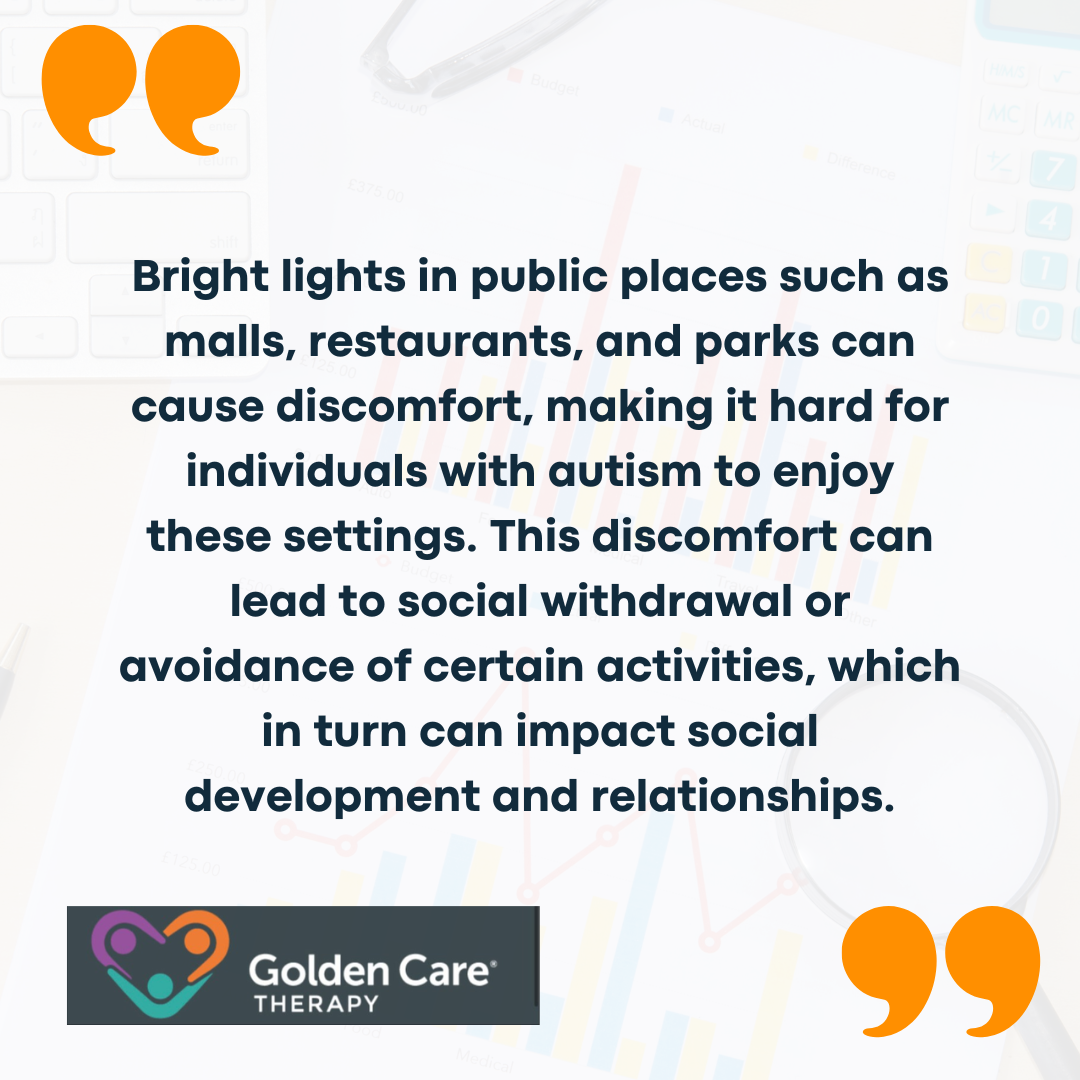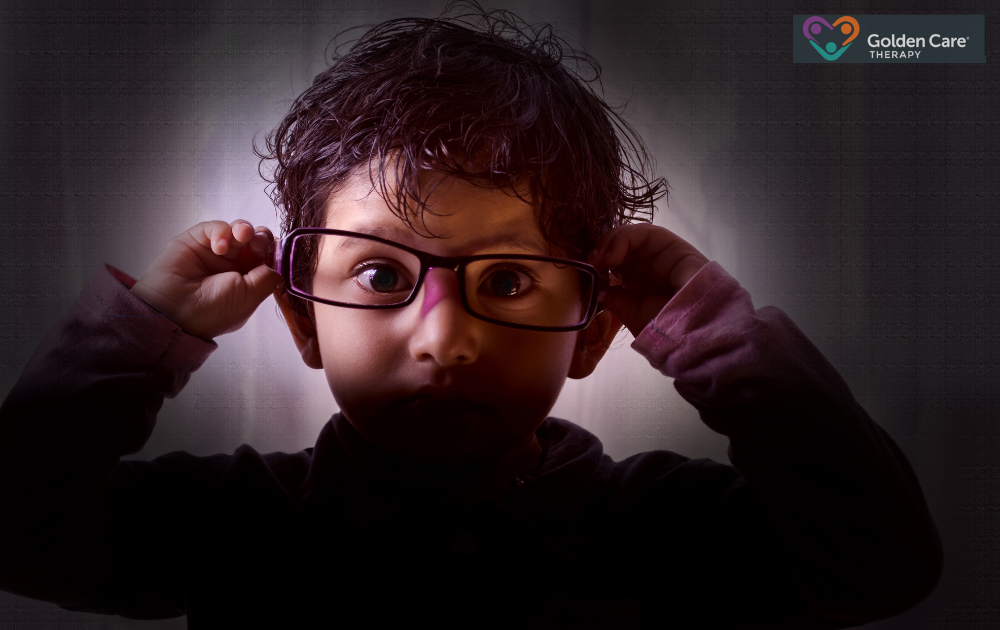Light sensitivity, also known as photophobia, is a common characteristic in individuals with autism spectrum disorder (ASD). This phenomenon can significantly affect daily life, causing discomfort and impacting the ability to function in various environments.
In this article, we’re going to look at light sensitivity in autism to explore its causes, effects, and strategies for management.

The Neurological Basis of Light Sensitivity in Autism
Light sensitivity is a form of hypersensitivity. For individuals with autism, ordinary levels of light that are comfortable for most people can be overwhelming, painful, or distracting. This sensitivity can lead to various challenges in everyday life, making it difficult to engage in activities, concentrate, or even relax.
The exact neurological underpinnings of light sensitivity in autism are not fully understood, but research suggests that differences in brain structure and function play a role. The brain of an individual with autism processes sensory information differently, which can result in an exaggerated response to stimuli such as light.
Studies have indicated that individuals with autism may have differences in the way their visual cortex processes light. The visual cortex is the part of the brain responsible for interpreting visual information. In some individuals with autism, this area of the brain may be hyperactive or overly responsive to light stimuli. This heightened activity can lead to discomfort or even pain when exposed to certain lighting conditions.
Moreover, research has shown that the neurotransmitter systems in the brains of individuals with autism may function differently. Neurotransmitters are chemicals that transmit signals between nerve cells. Imbalances in neurotransmitter systems, such as those involving serotonin and dopamine, have been linked to sensory processing issues in autism. These imbalances could contribute to the heightened sensitivity to light.

Manifestations of Light Sensitivity in Autism
Light sensitivity in autism can manifest in various ways depending on the individual. Some common manifestations include discomfort or pain in bright light, difficulty focusing or concentrating in well-lit environments, and an aversion to certain types of lighting, such as fluorescent lights.
For some individuals, light sensitivity may cause physical symptoms such as headaches, eye strain, or nausea. These symptoms can be particularly distressing and can significantly impact an individual’s ability to participate in daily activities.
For example, attending school, working in an office, or even going to a grocery store can become challenging tasks due to the discomfort caused by lighting conditions.
Light sensitivity can also affect an individual’s mood and behavior. The discomfort or pain associated with bright lights can lead to irritability, anxiety, or meltdowns. Meltdowns are intense emotional responses that can occur when an individual with autism becomes overwhelmed. These responses are often triggered by sensory overload, including exposure to bright lights.
Impact on Daily Life
The impact of light sensitivity on daily life can be profound. For children with autism, light sensitivity can interfere with their ability to learn and participate in school activities. Brightly lit classrooms, the glare from computer screens, and the use of fluorescent lighting can create an overwhelming environment that makes it difficult for them to concentrate or engage in tasks.
In social situations, light sensitivity can also pose challenges.

In the workplace, adults with autism who experience light sensitivity may struggle with typical office lighting conditions. This can affect their productivity and overall job satisfaction. The need to find suitable lighting conditions or to adapt to existing ones can add an extra layer of stress to their daily routines.
Strategies for Managing Light Sensitivity
Managing light sensitivity in autism requires a combination of environmental modifications, behavioral strategies, and sometimes medical interventions. The goal is to create a comfortable and supportive environment that minimizes the impact of light sensitivity on daily life.
One effective strategy is to modify the lighting in environments where the individual spends a significant amount of time. This can involve using softer, natural lighting instead of harsh fluorescent lights. Dimming the lights, using lamps with adjustable brightness, and installing blinds or curtains to control natural light can also help create a more comfortable environment.
Wearing tinted glasses or sunglasses is another common strategy. These glasses can filter out certain wavelengths of light that may be particularly bothersome, reducing the overall discomfort caused by bright lights. There are also specially designed lenses, such as Irlen lenses, that are intended to alleviate light sensitivity and improve visual comfort.
In addition to environmental modifications, behavioral strategies can be beneficial. Teaching individuals with autism coping techniques, such as deep breathing or taking breaks in dimly lit areas, can help them manage their light sensitivity. Creating a “sensory toolkit” with items like sunglasses, hats, and fidget toys can also provide individuals with tools to use when they feel overwhelmed by light.
In some cases, medical interventions may be necessary. Consulting with a healthcare professional, such as an optometrist or neurologist, can help determine if there are underlying medical conditions contributing to the light sensitivity.
Medications that address related issues, such as migraines or anxiety, may also be prescribed to help manage symptoms.
Research and Studies on Light Sensitivity in Autism
Several studies have explored the relationship between autism and light sensitivity, providing valuable insights into its prevalence and impact.
A study published in the journal “Autism Research” found that sensory sensitivities, including light sensitivity, are common in individuals with autism. The study reported that approximately 70-90% of individuals with autism experience some form of sensory sensitivity, with light sensitivity being one of the most frequently reported issues.
Another study conducted by researchers at Vanderbilt University examined the neural basis of sensory processing differences in autism. The study used functional magnetic resonance imaging (fMRI) to compare brain activity in individuals with autism and neurotypical individuals when exposed to light stimuli.
The results showed that individuals with autism had heightened activity in the visual cortex and other sensory processing areas, supporting the idea that differences in brain function contribute to light sensitivity.
Research has also explored the impact of light sensitivity on daily functioning and quality of life. A study investigated how sensory sensitivities affect the daily lives of children with autism. The study found that children with higher levels of sensory sensitivity, including light sensitivity, had more difficulty participating in school and social activities.
This highlights the importance of addressing sensory sensitivities to improve the overall well-being of individuals with autism.

Future Directions in Research and Support
As awareness of light sensitivity in autism grows, ongoing research and support initiatives are essential. Future research can help further elucidate the neurological mechanisms underlying light sensitivity and identify more effective interventions.
There is also a need for increased education and training for professionals working with individuals with autism. Educators, healthcare providers, and employers can benefit from understanding the impact of sensory sensitivities and learning how to create more accommodating environments.
Technology and design innovations offer promising avenues for support. The development of adaptive lighting systems that can adjust to individual sensitivities, as well as the creation of sensory-friendly public spaces, can greatly enhance the quality of life for individuals with autism.
In conclusion, light sensitivity is a significant and often challenging aspect of autism spectrum disorder. It affects daily life in various ways, from learning and working to social interactions and overall well-being. Understanding the neurological basis, manifestations, and impact of light sensitivity is crucial for developing effective strategies for management.
With continued research, support, and advocacy, we can create more inclusive environments that accommodate the sensory needs of individuals with autism, helping them to thrive and participate fully in their communities. We at Golden Care offer specialized ABA programs in NJ, Indiana, Georgia, and New York to support individuals with autism. If you need more information or want to book a consultation, don’t hesitate to get in touch with us today.
Sources:



